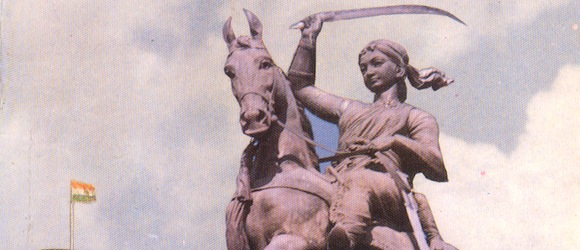The British National Army Museum recently ran an online poll to let the world choose the finalists (but not the winner) of the title of Britain’s Greatest Foe, giving the world twenty international historical icons to choose from, just so long as their lives happened no earlier than the 17th century (the earliest years covered by the museum) and that they also led an army, from the field, against British troops. This, naturally, disqualified a lot of folks from the running (Adolf Hitler comes readily to mind), but left some pretty impressive historical movers and shakers like Napoleon, George Washington, and Andrew Jackson. Among them there was only one woman, but someone we’ve mentioned briefly before: Rani Lakshmi Bai, or the Rani of Jhansi; who’s been described as “the Indian Joan of Arc,” “the bravest and the best,” and “the most dangerous rebel leaders” of the Indian Rebellion of 1857, by her enemies. Above, is just one of the statues of her that stand in India today.
Here’s the deal with her:
Born Lakshmi Bai, she enjoyed more freedom than the average girl of her time, in India or Britain, including a good education, horsemanship, archery, and swordfighting. She was married in 1842 to the Rajah of Jhansi, who would die eleven years later without leaving an heir. Though, following Hindu tradition, the Rani adopted an heir to keep the succession, but her kingdom was seized by the British East India Company under the Doctrine of Lapse, a law created by the British governor of India that allowed any indigenous government state in India to be seized by the crown if its rulers were “manifestly incompetent” or lacked an heir.
The Rani first attempted to win her lands and people back through the courts, but failed. The Company confiscated her royal jewels, reduced her annual pension, and threw her out of her home in Jhansi. Soon, however, the Company and the British army was pretty preoccupied with putting down the Indian Rebellion, and the Rani was at first reluctant to fight, content to merely keep the peace in Jhansi. Which she did, quite successfully, until Indian troops massacred a fort full of British noncombatants in cold blood. Whether the Rani was actually responsible for ordering their deaths is still hotly debated, with some arguing that she did, and others arguing that it was a fabricated story created to discredit her or force her hand. She protested her own innocence.
From that point on, the Rani became a significant threat to the British army, raising her own 14,000 strong force of men and women, and held Jhansi for almost a year before its defenses broke under a Major-General Sir Hugh Rose‘s siege, a battle that saw the deaths of five thousand of her citizens, including her the Rani’s father. Still, the Rani escaped, pursued by Rose, eventually meeting her end a few months later. From the Army Museum:
The Rani attempted to halt the flight of her soldiers, charging with a sword in each hand and reins in her teeth, but was shot by a trooper from the 8th (The King’s Royal Irish) Hussars. Knowing death was near, and not wanting the British to capture her body, she told her followers to burn her corpse. The cremation ceremony was unfinished when the hussars drove away the mourners.
Said Rose of the Rani afterward:
The Rani was remarkable for her bravery, cleverness and perseverance; her generosity to her subordinates was unbounded. These qualities, combined with her rank, rendered her the most dangerous of the rebel leaders.
While the Rani might not have won the competition, or even placed in the top five, she made it to the top ten, beating out Andrew Jackson, her countryman Tipu Sultan (known as the Tiger of Mysore), Prussian soldier Paul von Hindenberg, New Zealand rebel fighter Riwha Titokowaru, and other veterans of the Crimea and even an illegitimate son of the British crown. And as the only woman on the list, we’d say that makes her, at least in the Museum’s estimation, the most dangerous female foe of the British empire.
(via The Telegraph.)








Published: Apr 16, 2012 04:26 pm